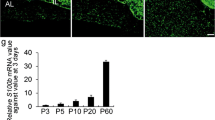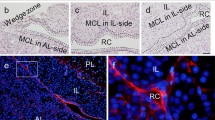Abstract
S100β-positive cells, which do not express the classical pituitary hormones, appear to possess multifunctional properties and are assumed to be heterogeneous in the anterior pituitary gland. The presence of several protein markers has shown that S100β-positive cells are composed of populations such as stem/progenitor cells, epithelial cells, astrocytes and dendritic cells. Recently, we succeeded in separating S100β-positive cells into round-cell (dendritic-cell-like) and process-cell types. We also found the characteristic expression of anti-inflammatory factors (interleukin-6, Il-6) and membrane receptors (integrin β-6) in the round type. Here, we further investigate the function of the subpopulation of S100β-positive cells. Since IL-6 is also a paracrine factor that regulates hormone producing-cells, we examine whether a correlation exists among extracellular acid stress, IL-6 and hormone production by using primary cultures of anterior pituitary cells. Dendritic-cell-like S100β-positive cells notably expressed Gpr68 (proton receptor) and Il-6. Furthermore, the expression of Il-6 and proopiomelanocortin (Pomc) was up-regulated by extracellular acidification. The functional role of IL-6 and GPR68 in the gene expression of Pomc during extracellular acidification was also examined. Small interfering RNA for Il-6 up-regulated Pomc expression and that for Gpr68 reversed the down-regulation of Il-6 and up-regulated Pomc expression by extracellular acidification. Thus, S100β-positive dendritic-like cells can sense an increase in extracellular protons via GPR68 and respond by the production of IL-6 in order to suppress the up-regulation of Pomc expression.






Similar content being viewed by others
References
Allaerts W, Vankelecom H (2005) History and perspectives of pituitary folliculo-stellate cell research. Eur J Endocrinol 153:1–12
Arzt E (2001) gp130 cytokine signaling in the pituitary gland: a paradigm for cytokine-neuro-endocrine pathways. J Clin Invest 108:1729–1733
Ceccatelli S, Hulting AL, Zhang X, Gustafsson L, Villar M, Hökfelt T (1993) Nitric oxide synthase in the rat anterior pituitary gland and the role of nitric oxide in regulation of luteinizing hormone secretion. Proc Natl Acad Sci U S A 90:11292–11296
Chen M, Kato T, Higuchi M, Yoshida S, Yako H, Kanno N, Kato Y (2013) Coxsackievirus and adenovirus receptor-positive cells compose the putative stem/progenitor cell niches in the marginal cell layer and parenchyma of the rat anterior pituitary. Cell Tissue Res 354:823–836
Ferrara N, Schweigerer L, Neufeld G, Mitchell R, Gospodarowicz D (1987) Pituitary follicular cells produce basic fibroblast growth factor. Proc Natl Acad Sci U S A 84:5773–5777
Fujiwara K, Kikuchi M, Takigami S, Kouki T, Yashiro T (2007a) Expression of retinaldehyde dehydrogenase 1 in the anterior pituitary glands of adult rats. Cell Tissue Res 329:321–327
Fujiwara K, Maekawa F, Kikuchi M, Takigami S, Yada T, Yashiro T (2007b) Expression of retinaldehyde dehydrogenase (RALDH)2 and RALDH3 but not RALDH1 in the developing anterior pituitary glands of rats. Cell Tissue Res 328:129–135
Gospodarowicz D, Lau K (1989) Pituitary follicular cells secrete both vascular endothelial growth factor and follistatin. Biochem Biophys Res Commun 165:292–298
Höfler H, Walter GF, Denk H (1984) Immunohistochemistry of folliculo-stellate cells in normal human adenohypophyses and in pituitary adenomas. Acta Neuropathol 65:35–40
Horiguchi K, Kikuchi M, Kusumoto K, Fujiwara K, Kouki T, Kawanishi K, Yashiro T (2010) Living-cell imaging of transgenic rat anterior pituitary cells in primary culture reveals novel characteristics of folliculo-stellate cells. J Endocrinol 204:115–123
Horiguchi K, Kouki T, Fujiwara K, Kikuchi M, Yashiro T (2011) The extracellular matrix component laminin promotes gap junction formation in the rat anterior pituitary gland. J Endocrinol 208:225–232
Horiguchi K, Ilmiawati C, Fujiwara K, Tsukada T, Kikuchi M, Yashiro T (2012) Expression of chemokine CXCL12 and its receptor CXCR4 in folliculostellate (FS) cells of the rat anterior pituitary gland: the CXCL12/CXCR4 axis induces interconnection of FS cells. Endocrinology 153:1717–1724
Horiguchi K, Fujiwara K, Yoshida S, Higuchi M, Tsukada T, Kanno N, Yashiro T, Tateno K, Ohsako S, Kato T, Kato Y (2014) Isolation of dendritic cell-like S100β-positive cells in rat anterior pituitary gland. Cell Tissue Res 357:301–308
Horvath E, Kovacs K (2002) Folliculo-stellate cells of the human pituitary: a type of adult stem cell? Ultrastruct Pathol 26:219–228
Ichimonji I, Tomura H, Mogi C, Sato K, Aoki H, Hisada T, Dobashi K, Ishizuka T, Mori M, Okajima F (2010) Extracellular acidification stimulates IL-6 production and Ca(2+) mobilization through proton-sensing OGR1 receptors in human airway smooth muscle cells. Am J Physiol Lung Cell Mol Physiol 299:L567–L577
Inoue K, Couch EF, Takano K, Ogawa S (1999) The structure and function of folliculo-stellate cells in the anterior pituitary gland. Arch Histol Cytol 62:205–218
Itakura E, Odaira K, Yokoyama K, Osuna M, Hara T, Inoue K (2007) Generation of transgenic rats expressing green fluorescent protein in S-100beta-producing pituitary folliculo-stellate cells and brain astrocytes. Endocrinology 148:1518–1523
Kurotani R, Yasuda M, Oyama K, Egashira N, Sugaya M, Teramoto A, Osamura RY (2001) Expression of interleukin-6, interleukin-6 receptor (gp80), and the receptor’s signal-transducing subunit (gp130) in human normal pituitary glands and pituitary adenomas. Mod Pathol 14:791–797
Lardner A (2001) The effects of extracellular pH on immune function. J Leukoc Biol 69:522–530
Lohrer P, Gloddek J, Nagashima AC, Korali Z, Hopfner U, Pereda MP, Arzt E, Stalla GK, Renner U (2000) Lipopolysaccharide directly stimulates the intrapituitary interleukin-6 production by folliculostellate cells via specific receptors and the p38alpha mitogen-activated protein kinase/nuclear factor-kappaB pathway. Endocrinology 141:4457–4465
Ludwig MG, Vanek M, Guerini D, Gasser JA, Jones CE, Junker U, Hofstetter H, Wolf RM, Seuwen K (2003) Proton-sensing G-protein-coupled receptors. Nature 425:93–98
Martínez D, Vermeulen M, Euw E von, Sabatté J, Maggíni J, Ceballos A, Trevani A, Nahmod K, Salamone G, Barrio M, Giordano M, Amigorena S, Geffner J (2007) Extracellular acidosis triggers the maturation of human dendritic cells and the production of IL-12. J Immunol 179:1950–1959
Mogi C, Tomura H, Tobo M, Wang JQ, Damirin A, Kon J, Komachi M, Hashimoto K, Sato K, Okajima F (2005) Sphingosylphosphorylcholine antagonizes proton-sensing ovarian cancer G-protein-coupled receptor 1 (OGR1)-mediated inositol phosphate production and cAMP accumulation. J Pharmacol Sci 99:160–167
Mogi C, Nakakura T, Okajima F (2013) Role of extracellular proton-sensing OGR1 in regulation of insulin secretion and pancreatic β-cell functions. Endocr J 61:101–110
Murakami N, Yokomizo T, Okuno T, Shimizu T (2004) G2A is a protonsensing G protein-coupled receptor antagonized by lysophosphatidylcholine. J Biol Chem 279:42484–42491
Nakakura T, Mogi C, Tobo M, Tomura H, Sato K, Kobayashi M, Ohnishi H, Tanaka S, Wayama M, Sugiyama T, Kitamura T, Harada A, Okajima F (2012) Deficiency of proton-sensing ovarian cancer G protein-coupled receptor 1 attenuates glucose-stimulated insulin secretion. Endocrinology 153:4171–4180
Pereda MP, Lohrer P, Kovalovsky D, Perez Castro C, Goldberg V, Losa M, Chervín A, Berner S, Molina H, Stalla GK, Renner U, Arzt E (2000) Interleukin-6 is inhibited by glucocorticoids and stimulates ACTH secretion and POMC expression in human corticotroph pituitary adenomas. Exp Clin Endocrinol Diabetes 108:202–207
Radu CG, Nijagal A, McLaughlin J, Wang L, Witte ON (2005) Differential proton sensitivity of related G protein-coupled receptors T cell death-associated gene 8 and G2A expressed in immune cells. Proc Natl Acad Sci U S A 102:1632–1637
Spangelo BL, Jarvis WD (1996) Lysophosphatidylcholine stimulates interleukin-6 release from rat anterior pituitary cells in vitro. Endocrinology 137:4419–4426
Spangelo BL, Judd AM, Isakson PC, MacLeod RM (1989) Interleukin-6 stimulates anterior pituitary hormone release in vitro. Endocrinology 125:575–577
Tachibana O, Yamashima T (1988) Immunohistochemical study of folliculo-stellate cells in human pituitary adenomas. Acta Neuropathol 76:458–464
Tatsuno I, Somogyvari-Vigh A, Mizuno K, Gottschall PE, Hidaka H, Arimura A (1991) Neuropeptide regulation of interleukin-6 production from the pituitary: stimulation by pituitary adenylate cyclase activating polypeptide and calcitonin gene-related peptide. Endocrinology 129:1797–1804
Tomura H, Mogi C, Sato K, Okajima F (2005) Proton-sensing and lysolipid-sensitive G-protein-coupled receptors: a novel type of multi-functional receptors. Cell Signal 17:1466–1476
Vankelecom H, Carmeliet P, Van Damme J, Billiau A, Denef C (1989) Production of interleukin-6 by folliculo-stellate cells of the anterior pituitary gland in a histiotypic cell aggregate culture system. Neuroendocrinology 49:102–106
Vila-Porcile E (1972) The network of the folliculo-stellate cells and the follicles of the adenohypophysis in the rat (pars distalis). Z Zellforch Microsk Anat Histochem 129:328–369
Xu Y (2002) Sphingosylphosphorylcholine and lysophosphatidylcholine: G protein-coupled receptors and receptor-mediated signal transduction. Biochim Biophys Acta 1582:81–88
Yoshida S, Kato T, Susa T, Cai LY, Nakayama M, Kato Y (2009) PROP1 coexists with SOX2 and induces PIT1-commitment cells. Biochem Biophys Res Commun 385:11–15
Yoshida S, Kato T, Yako H, Susa T, Cai LY, Osuna M, Inoue K, Kato Y (2011) Significant quantitative and qualitative transition in pituitary stem/progenitor cells occurs during the postnatal development of the rat anterior pituitary. J Neuroendocrinol 23:933–943
Yoshida S, Kato T, Higuchi M, Yako H, Chen M, Kanno N, Ueharu H, Kato Y (2013) Rapid transition of NESTIN-expressing dividing cells from PROP1-positive to PIT1-positive advances prenatal pituitary development. J Neuroendocrinol 25:779–791
Yoshimura F, Soji T, Sato S, Yokoyama M (1977) Development and differentiation of rat pituitary follicular cells under normal and some experimental conditions with special reference to an interpretation of renewal cell system. Endocrinol Jap 24:435–449
Acknowledgments
We thank Professor K. Inoue (Saitama University, Japan) for supplying the transgenic rats. We are also grateful to Professor T. Yashiro and Y. Hanazono (Jichi Medical University) for their generous assistance with fluorescence-activated cell sorting and for their valuable suggestions.
Conflicts of interest
The authors declare no conflict of interest that might prejudice the impartiality of this research.
Author information
Authors and Affiliations
Corresponding authors
Additional information
This work was supported by a Grant-in-Aid for Young Scientists (B) (25860148) from the Ministry of Education, Culture, Sports, Science and Technology of Japan. It was also partially supported by JSPS KAKENHI Grants (nos. 21380184 to Y.K. and 24580435 to T.K.) and by the Meiji University International Institute for BioResource Research (MUIIR).
Rights and permissions
About this article
Cite this article
Horiguchi, K., Higuchi, M., Yoshida, S. et al. Proton receptor GPR68 expression in dendritic-cell-like S100β-positive cells of rat anterior pituitary gland: GPR68 induces interleukin-6 gene expression in extracellular acidification. Cell Tissue Res 358, 515–525 (2014). https://doi.org/10.1007/s00441-014-1958-x
Received:
Accepted:
Published:
Issue Date:
DOI: https://doi.org/10.1007/s00441-014-1958-x




